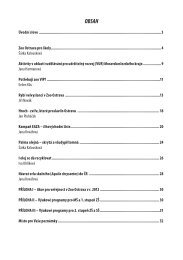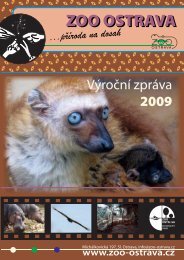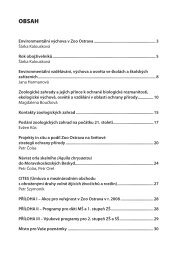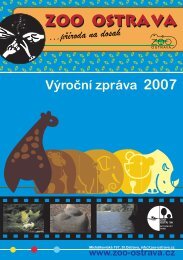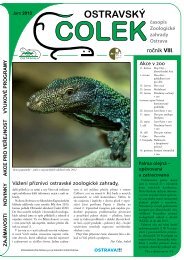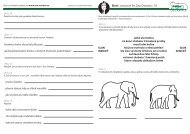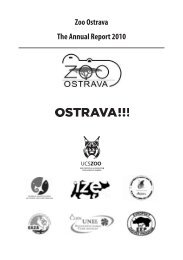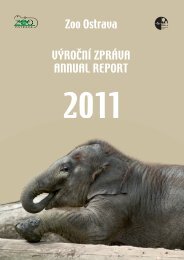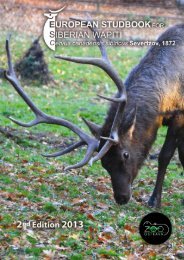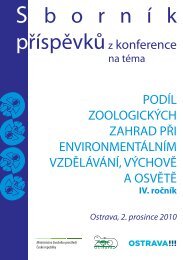You also want an ePaper? Increase the reach of your titles
YUMPU automatically turns print PDFs into web optimized ePapers that Google loves.
Keeping the common hippopotamus (Hippopotamus amphibius)<br />
at <strong>Ostrava</strong> <strong>Zoo</strong><br />
Jan Pluháček<br />
Dedicated to the memory of the longest-living dweller of <strong>Ostrava</strong> <strong>Zoo</strong>,<br />
Roza the hippo female<br />
On 7 October <strong>2009</strong> in the morning, the common hippo female Roza died at <strong>Ostrava</strong> <strong>Zoo</strong> after having suffered<br />
a difficult but very short disease. This animal was the longest-living inhabitant ever held in <strong>Ostrava</strong>. What's<br />
more, this female was a founder of zoo's common hippo stock. Not only the facts mentioned above, but also<br />
other events that concerned the <strong>Ostrava</strong> hippo stock in <strong>2009</strong> lead me to make a summary of the breeding<br />
history of this <strong>Ostrava</strong> <strong>Zoo</strong> flagship species from the very beginning, which dates back to 16 November 1967,<br />
when it was this very hippo, female Roza, who arrived at the then elephant house from the zoo in Dvur Kralove.<br />
Roza was six, as she was born to a female Tanga and Tanga's son Lutz II in Munich on 20 June 1961. Tanga had<br />
come from Leipzig and later became the longest-living hippo in the world - she died in Munich on 12 July 1995<br />
when she was 61 years old. Lutz II was fathered by Lutz I of Berlin origin. In 1966, Roza left Munich for Dvur<br />
Kralove <strong>Zoo</strong> together with her siblings, a female Dora and a male Heini, to subsequently continue to <strong>Ostrava</strong><br />
on her own a year later.<br />
<strong>The</strong> first male to follow Roza, named Honza, arrived at <strong>Ostrava</strong> on 13 July 1968. This hippo was born to<br />
a female Aenne II and a male Toni at Cologne <strong>Zoo</strong> on 20 July 1967. <strong>The</strong> fact that Toni's parents were caught in<br />
the wild and Aenne II was imported from the wild as well places Honza amongst a few European hippos with<br />
fully known pedigree.<br />
An important milestone for the hippo stock at <strong>Ostrava</strong> <strong>Zoo</strong> arrived on 30 January 1972 for it was the date<br />
of birth for a first calf of Honza and Roza. This animal turned out to be a female and was named Dita. Reared<br />
with success, Dita was the very first common hippo born in the then Czechoslovakia, by which <strong>Ostrava</strong> <strong>Zoo</strong> got<br />
several months ahead of Prague and Dvur Kralove parks, with Prague having held hippos as early as in 1933<br />
and Dvur Kralove having been a hippo holder since 1966. In Dvur Kralove, they bred their first hippo in August<br />
1972, while Prague was not successful in this before May 1974. On 24 May 1975, Dita was sold to Dutch animal<br />
dealer Van den Brink and her fate is unfortunately unknown.<br />
In 1975, hippos were moved to a new annex to the house that has remained in service until today, in fact in<br />
unchanged form. Here the animals have available a relatively large pool (108 m 2 ) that can be divided when<br />
necessary. <strong>The</strong> dry area (51 m 2 ) can be split in two as well, with both sections providing access to the pool by<br />
means of stairs. <strong>The</strong>re is an outdoor enclosure of 387 m 2 adjoining the house, to which the animals can access<br />
from the indoor pool, as there is no pool outdoors.<br />
From the many more calves produced by the hippo pair, a female Katka born on 31 August 1977 is worth<br />
to mention, as it was the only young hippo that ever stayed in <strong>Ostrava</strong> until full maturity. Katka was and still<br />
is mated by her father Honza. Her first calf was born on 22 October 1982, meaning that she was then 5; the<br />
young one was a female Alenka, who was subsequently sold to an animal dealer as well, this time Muller<br />
Company, thus being another animal without any additional details of life history.<br />
65



